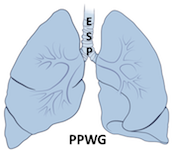AMR diagnosis remains a challenge in lung transplantation due to
confounding factors and the absence of diagnostic tools with an
acceptable level of confidence. Consequently, solid case series with
clinical data are limited.
Underlying diseases
AMR appears to affect younger patients as reported by Witt (1) in a
single cohort of 21 cases with a diagnosis based on circulating DSA,
consistent histopathology, C4d deposition and graft dysfunction.
In a retrospective study, Lobo (2) highlights the higher prevalence of
DSA in cystic fibrosis patients. The presence of autoimmune and autoantibodies
in cystic fibrosis with a yet unknown cross-reactivity and the poor treatment
compliance appear to be a predisposing condition to AMR.
Clinical, functional and imaging data
Clinical phenothypes in lung AMR are related to several clinical profiles (5):
- Hyperacute AMR is very rare. It consists of early post-operative graft
dysfunction with acute pulmonary edema and has a poor prognosis.
Diagnostic assessment is based on the presence of pre-formed donor-directed
antibodies and post-mortem histopathology.
- Acute AMR can occur at different times after transplantation, in the first
months or later (1). Presentation is nonspecific: dyspnea, cough, hemoptysis,
pulmonary infiltrates, hypoxemia, FEV1 decrease, with possible acute
respiratory failure. Acute AMR is generally refractory to high-dose
corticosteroids whereas a better response can be obtained with a combination
of plasmapheresis, immunoglobulins and/or Rituximab. Outcome is variable
from total recovery to absence of response and relapses, but is generally
poor with a high incidence of CLAD development (1-6).
- Chronic/late AMR: the importance of late onset AMR is increasingly recognized.
It has been known as a major cause of late graft dysfunction in renal and
cardiac transplantation (7,8). In the lung transplant field there are only
anecdotic cases reported (9) and the topic needs to be studied in depth.
A multidisciplinary approach is essential to make a diagnosis of pulmonary AMR.
Histopathology and immunology have a crucial diagnostic place after
exclusion of infection, left ventricular failure and drug induced lung disease.
Further studies are needed to better identify clinical, imaging and
functional phenotypes of pulmonary AMR.
Sandrine Hirschi (Pulmonologist, University Hospital of Strasbourg, F)
References :
1. Witt CA, Gaut JP, Yusen RD, et al. Acute antibody-mediated rejection after lung transplantation. J Heart Lung Transplant. 2013 Oct;32(10):1034-40.
2. Lobo LJ, Aris RM, Schmitz J, Neuringer IP. Donor-specific antibodies are associated with antibody-mediated rejection, acute cellular rejection, bronchiolitis obliterans syndrome, and cystic fibrosis after lung transplantation. J Heart Lung Transplant. 2013 Jan;32(1):70-7.
3. Chin N, Westall G, Paraskeva M, et al. Challenges inherent to the diagnosis of antibody-mediated rejection in lung transplantation. Respirol Case Rep. 2015 Mar;3(1):36-9.
4. Dew MA, Dabbs AD, Myaskovsky L. Mata-analysis of medical regimen adherence outcomes in pediatric solid organ transplantation. Transplantation. 2009;88(5):736–746.
5. Glanville AR. Antibody-mediated rejection in lung transplantation: myth or reality? J Heart Lung Transplant. 2010;29:395–400.
6. Morrell MR, Pilewski JM, Gries CJ, et al. De novo donor-specific HLA antibodies are associated with early and high-grade bronchiolitis obliterans syndrome and death after lung transplantation. J Heart Lung Transplant. 2014 Dec;33(12):1288-94.
7. Qiquan Sun and Yang Yang. Late and chronic antibody-mediated rejection: main barrier to long term graft survival. Clin Dev Immunol. 2013;2013:859761.
8. Coutance G, Ouldamar S, Rouvier P, Saheb S, Suberbielle C, Bréchot N, Hariri S, Lebreton G, Leprince P, Varnous S. Late antibody-mediated rejection after heart transplantation: Mortality, graft function, and fulminant cardiac allograft vasculopathy. J Heart Lung Transplant. 2015;34(8):1050-7.
9. Yamamoto H, Yoshida K, Koizumi T, Tokoro Y, Fukushima T, Tateishi K, Ushiki A, Yokoyama T, Yasuo M, Urushihata K, Hanaoka M, Shingu K, Shimojo H, Kanno H, Yoshizawa A, Kawakami S, Miyagawa-Hayashino A, Date H, Kubo K. Late-onset rejection of a unilateral donor lung with vascular C4d deposition in bilateral living-donor lobar lung transplantation: an autopsy case report. Intern Med. 2014;53(15):1645-50.


